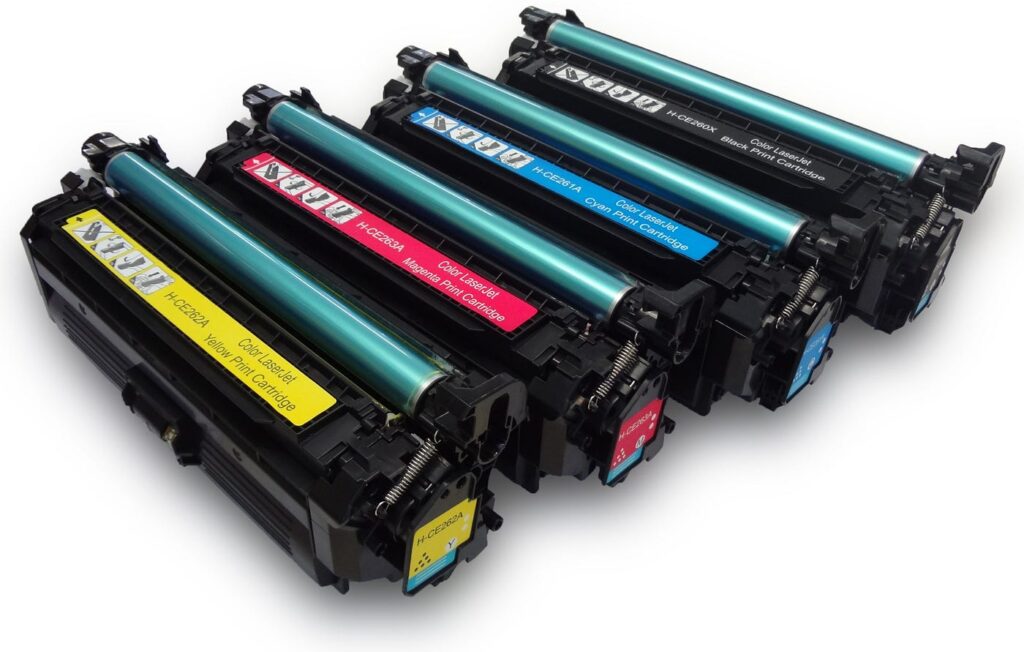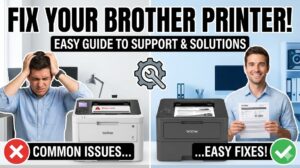Introduction
Common printer problems office solutions are essential knowledge for any workplace that depends on reliable document production. In today’s fast-paced business environment, printer downtime can paralyze productivity, delay important presentations, and frustrate employees who need immediate access to hard copies of critical documents.
Office environments present unique challenges for printer maintenance and troubleshooting. High-volume usage, multiple users with varying technical skills, and the pressure to maintain continuous operation create a perfect storm for printer malfunctions. Unlike home printers that serve one or two users occasionally, office printers must perform consistently under demanding conditions while serving dozens of employees daily.
The good news is that most office printer problems follow predictable patterns and have straightforward solutions that don’t require expensive service calls or lengthy downtime. This comprehensive guide provides busy office managers and IT staff with practical troubleshooting strategies that can be implemented quickly to restore printing functionality and maintain workplace productivity.
What Are Office Printer Management Challenges?
Office printer management involves maintaining reliable printing services for multiple users while minimizing downtime, controlling costs, and ensuring consistent output quality. This complex task requires understanding both the technical aspects of printer operation and the unique demands of workplace environments.
The primary challenge lies in balancing high-volume usage with preventive maintenance requirements. Office printers typically handle hundreds or thousands of pages daily, placing significant stress on mechanical components and consumables. This intensive use accelerates wear patterns and increases the likelihood of malfunctions during critical business hours.
User management presents another significant challenge, as office printers serve employees with varying levels of technical expertise. Problems arise when users attempt to fix issues incorrectly, ignore error messages, or fail to report problems promptly. Additionally, different departments may have conflicting printing needs, from high-quality marketing materials to simple text documents.
Cost control becomes crucial when managing office printing infrastructure. Unexpected repairs, emergency service calls, and premature equipment replacement can significantly impact operational budgets. Effective printer management strategies focus on preventive measures, standardized troubleshooting procedures, and employee training to minimize these unexpected expenses while maintaining reliable service.
8 Critical Office Printer Problems and Quick Solutions

1. Network Connectivity Issues in Multi-User Environments
Network printer problems are among the most disruptive office issues, preventing multiple users from accessing printing services simultaneously.
Immediate Solutions:
- Check that the printer’s IP address hasn’t changed due to DHCP renewal
- Restart the network switch and printer to refresh connections
- Verify that printer drivers are updated across all connected computers
- Ensure the printer is connected to the correct network segment
- Test connectivity by printing a network configuration page
- Configure a static IP address to prevent future DHCP conflicts
2. High-Volume Paper Jams and Feed Problems
Heavy office usage increases paper jam frequency, especially when multiple users load different paper types incorrectly.
Step-by-Step Resolution:
- Establish clear paper loading procedures for all staff members
- Remove jammed paper following the paper path direction
- Check paper guides and adjust them properly for the loaded paper size
- Inspect feed rollers for dust buildup and clean them monthly
- Ensure paper quality meets manufacturer specifications
- Limit paper tray capacity to prevent overstuffing

3. Toner and Ink Cartridge Management
Office printers consume consumables rapidly, leading to frequent “low toner” warnings and cartridge replacement needs.
Efficient Management Strategies:
- Implement inventory tracking to maintain adequate cartridge supplies
- Train staff to recognize legitimate low-toner warnings versus false alerts
- Establish procedures for proper cartridge installation and handling
- Consider genuine versus compatible cartridges based on volume needs
- Set up automatic ordering systems tied to usage monitoring
- Document cartridge replacement procedures to ensure consistency
4. Print Quality Degradation Under Heavy Use
Continuous high-volume printing can cause print quality to deteriorate, affecting professional document appearance.
Quality Maintenance Solutions:
- Schedule regular cleaning cycles during off-hours
- Monitor and replace imaging components before complete failure
- Calibrate color settings monthly for consistent output
- Use appropriate paper grades for different document types
- Implement print settings standards across departments
- Track usage patterns to predict maintenance needs
5. Print Queue Backups and Job Management
Multiple users sending large print jobs can create queue bottlenecks and system conflicts.
Queue Management Techniques:
- Install print queue management software for better control
- Establish print job priorities for different document types
- Train users to cancel unwanted jobs promptly
- Set up separate queues for different paper sizes or special jobs
- Monitor queue status regularly during peak usage periods
- Implement user authentication to prevent unauthorized printing

6. Security and Access Control Issues
Office printers often store sensitive documents in memory or on hard drives, creating potential security vulnerabilities.
Security Implementation Steps:
- Enable user authentication for all print jobs
- Configure automatic document deletion from printer memory
- Set up secure print release requiring physical presence
- Regularly update printer firmware to address security patches
- Establish policies for confidential document handling
- Monitor print logs for unusual activity patterns
7. Maintenance Scheduling in Busy Environments
Regular maintenance becomes challenging when printers must remain operational during business hours.
Strategic Maintenance Planning:
- Schedule preventive maintenance during low-usage periods
- Create maintenance checklists for different intervals (daily, weekly, monthly)
- Train multiple staff members in basic troubleshooting procedures
- Maintain spare parts inventory for common replacements
- Document all maintenance activities for warranty and service records
- Establish backup printing options during maintenance periods
8. Multi-Function Device Complexity
Modern office printers often include scanning, copying, and faxing capabilities that create additional troubleshooting challenges.
Comprehensive Device Management:
- Train users on all device functions to prevent operator errors
- Update drivers for all integrated functions regularly
- Test each function weekly to identify problems early
- Maintain separate troubleshooting procedures for each capability
- Monitor usage across all functions to predict component wear
- Configure network settings properly for all integrated services

Advanced Office Printer Management Tools
Enterprise-level printer management software provides centralized monitoring and control capabilities that dramatically improve office printing efficiency. These systems offer real-time status monitoring, automatic supply ordering, and predictive maintenance alerts that prevent problems before they impact operations.
Cloud-based printer management platforms allow remote monitoring and troubleshooting, enabling IT staff to resolve many issues without physically visiting the printer location. These tools often include usage analytics, cost tracking, and security monitoring features that provide valuable insights for optimizing printing operations.
Mobile device management integration enables employees to print securely from smartphones and tablets while maintaining document security and access controls. Modern solutions include features like pull printing, where documents are released only when the user is physically present at the printer.
Print server solutions provide centralized job processing, queue management, and driver distribution that simplifies multi-printer environments. These systems can automatically balance print loads across multiple devices and provide failover capabilities when individual printers experience problems.
Critical Mistakes That Disrupt Office Printing
The most costly mistake offices make is delaying routine maintenance until problems become severe. Preventive maintenance costs significantly less than emergency repairs and prevents the productivity losses associated with unexpected downtime. Waiting for complete component failure often leads to secondary damage that could have been avoided.
Inadequate user training creates ongoing problems as employees attempt to resolve issues incorrectly or ignore warning signs that indicate developing problems. Investing time in comprehensive printer training for all staff members pays dividends in reduced service calls and fewer user-induced problems.
Purchasing decisions based solely on initial cost often result in higher long-term expenses due to expensive consumables, frequent repairs, or inadequate capacity for office needs. Consider total cost of ownership, including supplies, maintenance, and energy consumption when selecting office printers.
Ignoring security considerations exposes sensitive business information to unauthorized access. Modern office printers store documents in memory and on hard drives, creating potential data breaches if proper security measures aren’t implemented and maintained.
Poor inventory management leads to unexpected supply shortages that can halt printing operations during critical business periods. Maintain adequate supplies of consumables and establish automatic reordering systems to prevent disruptions.
Frequently Asked Questions
Q: How often should we perform maintenance on high-volume office printers? A: High-volume office printers require daily visual inspections, weekly cleaning of accessible components, monthly comprehensive maintenance, and quarterly professional service. Usage over 5,000 pages monthly may require more frequent attention.
Q: What’s the best way to handle printer problems when IT staff isn’t available? A: Train multiple employees in basic troubleshooting procedures, maintain clear written instructions near each printer, establish relationships with local service providers for emergency support, and consider remote monitoring services for immediate assistance.
Q: Should we buy genuine cartridges or use compatible alternatives for office printers? A: For high-volume office use, genuine cartridges typically provide better reliability and print quality. However, high-quality compatible cartridges from reputable suppliers can offer significant cost savings. Test compatible options thoroughly before committing to large quantities.
Q: How can we reduce printing costs without affecting productivity? A: Implement duplex printing as default, use draft mode for internal documents, establish print quotas by user or department, digitize workflows where possible, and regularly audit printing habits to identify waste reduction opportunities.
Conclusion
Mastering common printer problems office solutions is crucial for maintaining workplace productivity and controlling operational costs. The strategies outlined in this guide provide practical approaches to the most frequent printing challenges that busy offices face daily.
Successful office printer management requires a proactive approach that combines preventive maintenance, user training, and systematic troubleshooting procedures. By implementing these solutions and avoiding common mistakes, offices can significantly reduce downtime, extend equipment life, and maintain consistent printing quality under demanding conditions.
Remember that investing in proper printer management pays dividends through reduced service costs, improved reliability, and enhanced employee productivity. Regular maintenance, adequate supply inventory, and well-trained staff create a printing environment that supports rather than hinders business operations. With these tools and knowledge, your office can maintain reliable printing services that meet the demands of today’s fast-paced business environment./isolated-segment.
How to Solve Printer Problems at Home: Quick DIY Troubleshooting Guide Read More




